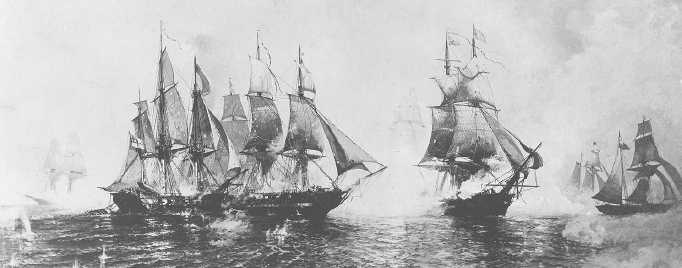| |
Decatur was popular with his men. He
deplored oaths and flogging—the customary
methods of discipline used at that time. He often
addressed his men directly, explaining the kind of
conduct he expected of them. Decatur won respect
not by demanding it, but by deserving it.
OLIVER HAZARD PERRY
Many fighting slogans were coined during the
War of 1812. James Lawrence’s dying words,
“Don’t give up the ship,” uttered in the ill-fated
Chesapeake, became the battle cry of the Navy.
Oliver Hazard Perry carried them to Lake Erie
where a flag containing the words “Don’t give up
the ship” was hoisted on his ship.
During the Battle of Lake Erie, with four-fifths
of the crew dead or wounded and his ship, the
Lawrence, crippled, Perry faced defeat. He made a
perilous passage in an open boat to another ship,
the Niagara, under the guns of the enemy.
Exhibiting extraordinary shrewdness and courage
in a surprise maneuver, he sailed the Niagara (fig.
2-7) into battle and defeated the enemy within 15
minutes.
DR. USHER PARSONS
A hero and tradition maker seldom mentioned
in descriptions of the Battle of Lake Erie was Dr.
Usher Parsons. Dr. Parsons was the only surgeon
aboard the Lawrence during that battle.
Ships of this era were shallow-built with
unprotected cockpits. (A cockpit was the junior
officers quarters, usually located below the
waterline.) During the Battle of Lake Erie, the
doctor tended the wounded on the wardroom floor,
which was nearly level with the surface of the
water. Unprotected from enemy fire, this hot and
crowded spot served as the operating room and
hospital in which Parsons and his assistants
carried on their work.
When all able men were needed on deck to
fight, the doctor carried on single-handed. During
the battle, five cannon balls crashed through the
wardroom, one of them killing two men lying on
the operating table. In all, Dr. Parson amputated
six limbs and dressed the wounds of many men
before he finally transferred with Perry to the
Niagara.
Of the 96 men wounded in the battle, only 3
died—a remarkable tribute to the skill of the 25-
year-old surgeon. In a letter to the Secretary of the
Navy, Perry wrote, “Of Dr. Parsons, surgeon’s
mate, I cannot say too much.” Dr. Parsons was
only one of many doctors who made bravery a
naval tradition. During the quasi-war with France
and the War of 1812, the names of 34 medical
officers were included in a resolution by a grateful
Congress.
THOMAS MACDONOUGH
Of perhaps greater importance than Perry’s
victory was Thomas MacDonough’s brilliant
triumph over the British fleet on Lake Champlain.
As the enemy ships closed in, “young Mac-
Donough, who feared his foes not at all, but his
God a great deal, knelt for a moment with his
officers on the quarterdeck.”
134.10
Figure 2-7.-A surprise maneuver turns defeat into victory. Leaving the crippled Lawrence, Perry
boarded the Niagara, sailed through the British lines, and attained victory in 15 minutes.
2-10
|

